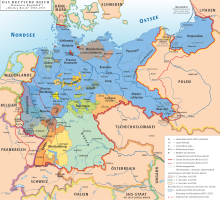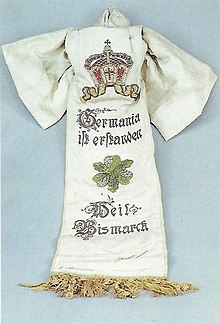German Reich
![]()
The title of this article is ambiguous. For the revolutionary restructuring attempt of the German Confederation, see German Empire 1848/1849.
German Reich was the name of the German nation-state between 1871 and 1945. Initially not congruent, the name also became the constitutional designation of Germany. After the "Anschluss" of Austria in March 1938, the name "Greater German Reich" came into propagandistic and official use. A Fuehrer decree in June 1943 instructed the institutions of the state to use this designation in the future.
The term German Empire is also occasionally used to refer to the Holy Roman Empire (962-1806): a supranational, ultimately supranational ruling entity that had been given the suffix "German Nation" from the 15th/16th century onwards.
In 1848, during the March Revolution, a "German Empire" was created as a German federal state. Its imperial government and thus the provisional constitution were recognized by the Bundestag of the German Confederation. In the spring of 1849, however, the Prussian King Frederick William IV had the revolution put down, and the elaborated constitution could not prevail.
In the German Empire of the 19th and 20th centuries, one generally distinguishes between several periods: the monarchy of the German Empire (1871-1918), the pluralistic, semi-presidential democracy of the Weimar Republic (1918/19-1933), and the dictatorship of the Nazi state during the period of National Socialism (1933 to 1945). In the following transitional period of occupied Germany until 1949, the term had already largely fallen into disuse. In the initially disputed question of whether the German Reich had continued to exist after 1945, from the end of the 1940s and finally with the decision of the Federal Constitutional Court of 31 July 1973, the thesis prevailed that the German Reich had survived the collapse of 1945. The Federal Republic was not its "legal successor", but was rather identical as a state with the state "German Reich"; with regard to the spatial extent, the old Federal Republic of Germany was "partly identical" (teilkongruent) until 1990. From the formula of spatial partial identity it followed: "The GDR belongs to Germany" (BVerfGE 36, 17), but not to the Federal Republic.

German Reich 1920-1937
-de.svg.png)
German Empire from 1871 to the end of the First World War and the fall of the Empire
Founding of the German Empire in 1871
→ Main article: Founding of the German Empire
The German Empire formally came into being on 1 January 1871 with the entry into force of a common constitution. The constitutional text corresponded to the text of the North German Federal Constitution in the version after the Baden-Hesse Treaty. After the German southern states - Bavaria, Württemberg, Baden and Hesse - had decided in the November Treaties of 1870 to establish a German Confederation by joining the North German Confederation, it had still been agreed on 10 December to replace the designation "German Confederation" by "German Empire" and to give the "Federal Presidency" the title "German Emperor". As a national state, the Reich subsumed all Germans, with the exception of German Austrians, Luxembourgers and Liechtensteiners. Austria had expressly agreed to the expansion of the North German Confederation across the Main River on December 25, 1870, thus recognizing the Reich under international law. The founding of the empire took place virtually at the invitation of the most powerful German monarch to the other German rulers. It was in this spirit that the Prussian king's imperial proclamation was staged in the Hall of Mirrors at Versailles on 18 January 1871. This date was celebrated as the Founding Day of the German Empire, but was not elevated to a public holiday, as January 18 already commemorated the coronation of Frederick I as Prussian king. The important holidays of the German Empire were rather Kaiser's Birthday and Sedan Day. After the first all-German Reichstag elections, Emperor Wilhelm I opened the Reichstag on March 21, 1871. The Reichstag edited the incomplete constitution, the draft of which was available on 16 April, promulgated on 20 April and came into force on 4 May 1871.

Vivatband for Bismarck
History
The history of the German Reich is divided into three or, if one includes the period of occupation, four periods:
- 1871-1918 German Empire under the Bismarckian Imperial Constitution
1871-1890 Time of the Reich Chancellor Otto von Bismarck
1890-1918 Wilhelminian era and First World War
- 1919-1933 Weimar Republic under the Weimar Imperial Constitution
- 1933-1945 Period of National Socialism with the NS state as a system of rule; propaganda name until 1939: "Third Reich"; official state name from 1943: "Greater German Reich".
- 1945-1949 divided into occupation zones by the main victorious powers of the Second World War, henceforth referred to as "Germany as a whole" ("Deutschland als Ganzes") and placed under the Allied Control Council, the supreme governmental authority, as a whole and the military governors in the individual zones as trustees (→ Postwar Germany, Deutschland 1945 bis 1949).
When the Spanish Queen Isabella II was overthrown in 1868, the Hereditary Prince Leopold of the Catholic Princely House of Hohenzollern-Sigmaringen offered his services as future king at Bismarck's instigation in the Spanish succession question. Because of the violent reaction in France, he immediately withdrew his candidacy. Nevertheless, the diplomatic conflict escalated into a national issue, as neither side wanted or could bear any loss of prestige. France felt that its prestige or even its security was threatened and tried to stop the royal election militarily. France felt challenged by the Ems Dispatch and declared war on Prussia in July 1870. The Franco-Prussian War was successful for the German armies, and they occupied Paris in early 1871. Bismarck used the war to achieve his goal of unifying the German states through a common enemy.
After the military defeat of the German Reich in World War II, Germany was placed under occupation by British, French, American and Soviet troops in 1945. The territories east of the Oder and Neisse rivers and the city of Swinemünde to the west of this line (in accordance with the provisions of the Potsdam Agreement) and, in addition, the city of Stettin (in total about a quarter of the area of 1937) were effectively separated from the Reich and, according to the Potsdam Agreement, placed "provisionally" under Polish or Soviet administration - but ultimately de facto annexed. The German population living in the eastern territories was largely expelled in the following years in violation of international law, unless they had already fled to the west in the course of the war.
With the re-establishment of the Republic of Austria from 27 April 1945 (Declaration of Independence) - until 1955 under the four occupying powers, then as a sovereign state -, the founding of the Federal Republic of Germany and the German Democratic Republic in 1949, the German Reich ceased to exist de facto from a historical point of view (as a result of complete wartime defeat and military occupation), but by no means de jure: The Weimar Constitution was not officially abrogated, nor was the German Reich dissolved, even after the German surrender in May 1945 and the assumption of sovereignty over Germany by the four occupying powers. The consequences resulting from this de jure continued existence are explained in the section on constitutional law issues after 1945.

The Munich Agreement of 1938 represents the last territorial status of the German Reich agreed by treaty with other powers (but not the affected Czechoslovakia). The "dismemberment of the rest of Czechoslovakia" in 1939 and its de facto annexation as the Protectorate of Bohemia and Moravia was an act contrary to international law, which was tolerated because of the appeasement policy of the Western powers.
Questions and Answers
Q: What was the official name of Germany from 1871 to 1945?
A: The official name of Germany from 1871 to 1945 was German Reich.
Q: How is the history of Germany during the time of the German Reich usually broken down?
A: The history of Germany during the time of the German Reich is usually broken down into three parts.
Q: When did the German Reich come to an end?
A: The German Reich came to an end in 1945.
Q: What is the meaning of the German term "Deutsches Reich"?
A: The German term "Deutsches Reich" translates to English as "German Reich".
Q: How long did the German Reich last as a political entity?
A: The German Reich lasted as a political entity for 74 years.
Q: Why was the history of Germany during the time of the German Reich divided into three parts?
A: The history of Germany during the time of the German Reich was divided into three parts because of the significant movements, events and changes that took place in the time period.
Q: What are the three parts that the history of Germany during the time of the German Reich is divided into?
A: The three parts that the history of Germany during the time of the German Reich is divided into are not provided in the given text.
Search within the encyclopedia